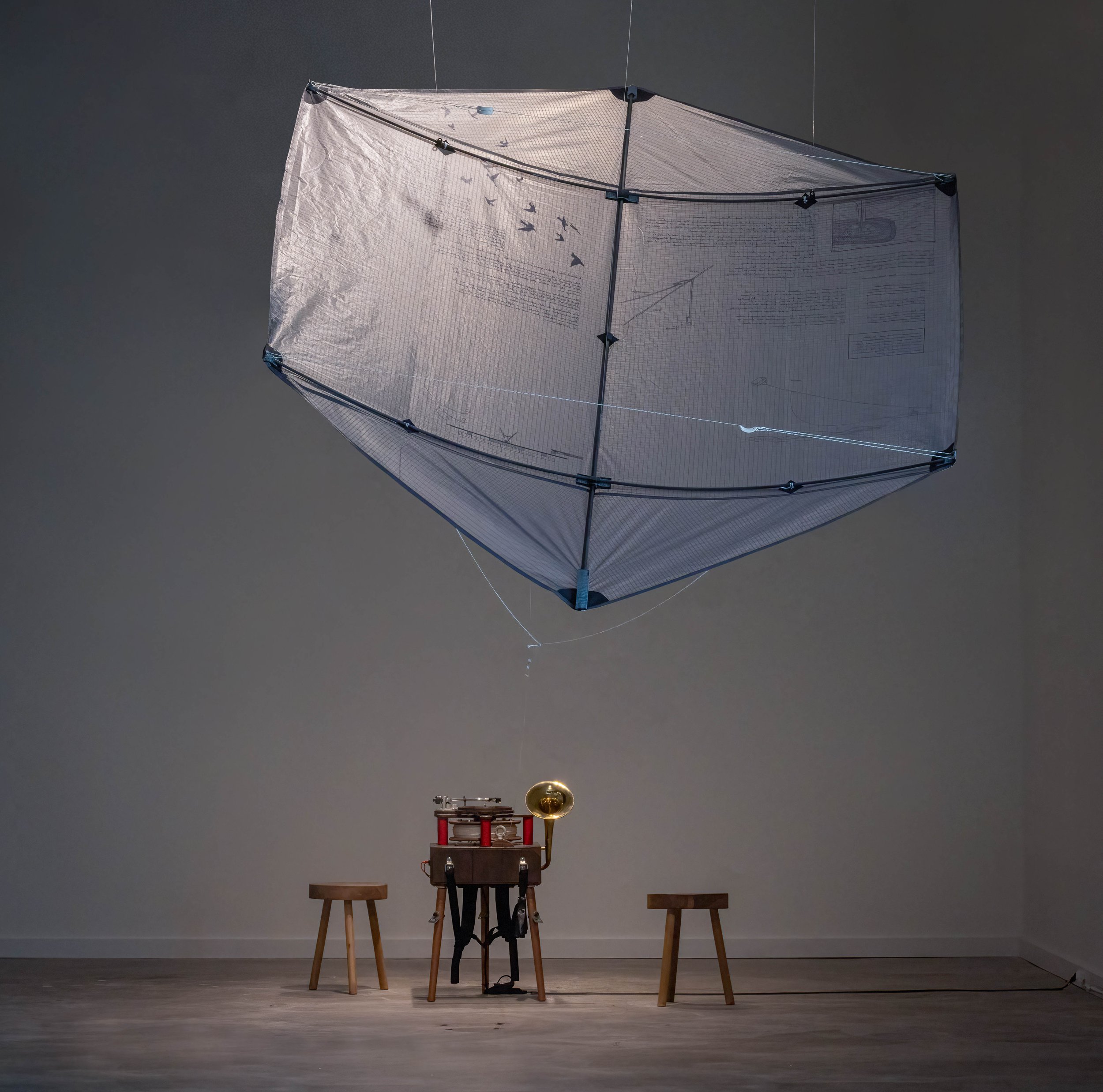UPEPO MWEUSI
Upepo Mweusi, presented as part of the Stove Works exhibition A Plague of Starlings, curated by Ashley Stull Meyers, is a reflection on Black relationships with nature in the United States. Clearly slavery and white supremacy have impacted the established connections with the natural world held by Black people. Some of these harms present themselves today through the actions we take to render ourselves as legible, and therefore safe, as we move through the world. These actions have become reflexive, instinctual ways of surviving in a world that can punish you for just existing. So we are conscious of what we wear, how we move, what we carry, our gestures. These things can lead to moving through the world in a way that feels compromised. It is no exaggeration to state that it can be unsafe to bring your full self into the world.
The sculpture is an example of that burden in that it can be worn as a backpack and carried with you while birding, but it is also a rejection of the idea that we have to move in any way that is diminished. Instead it offers a chance to walk through the world with a 7 foot black kite and a record player on your back in a gesture that claims space and asserts your right to be.
It is principally a vehicle for gathering people together to talk about these themes and to share stories about both the joys and trials of navigating the natural world as a Black person in this country, at this time. The kite acts as a journal, a record of the times it has flown and the stories it has heard. Audio recordings emerge from the bell, the voices of Black birders recounting their experiences in the natural world, bringing their voices into the room to extend the scale of the work beyond the walls of the gallery.
And the nature of the work means that the conditions have to be right in order for the kite to get airborne, just as the conditions have to be right when Black folks leave the house.
Below, I share the rough notes I wrote when envisioning the work. As an educator I think it’s important to be transparent when discussing how art comes into being. The ideas will often evolve, shaped by the questions and possibilities inherent in the act of making a work. It’s best not to have a rigid grasp on your initial ideas. They are starting points and they get you into a position to see the meaning and possibility in your practice. There are elements in the description that did not come to be. Navigating timing, budget, and circumstance is also part of process.
I've been reflecting on what it means to be black in nature, in this society.
I'm thinking of the burden we carry reflexively... we always have to consider how we move, how we stand still, where we go, what we hold, how we hold it, where our attention is focused and whether that is enough to instill fear, be alert to our own fear and the distribution of our attention in order to maintain safe conditions, and the possibility that even in the best conditions we may be harmed.
This is second nature. How then to illustrate the survival mechanisms we employ? Make them visible, make them future, make them more inventive and overpowering than the fears of those we encounter. Make it pedagogical, make it burdensome and also fun. Make it disregard and disrupt the white gaze.
Pondering tools for being black in nature given current conditions.
So my initial idea is to find a great talk by a black/indigenous scholar about the relationships/legacies we have and had with our natural spaces. Press a vinyl record of the talk. Sew a dark gray Rokkaku kite (7 or 8 feet tall) to use with a kite driven turntable that I build into a garment/backpack. Also build into the device a couple of stools, possibly modeled after those from my village.
I would wear the piece when I was out birding, cataloging conversations and experiences. I'd have to only bird where it is possible to get a kite aloft. I see the kite and audio recording as a safety mechanism of sorts, deflecting or increasing suspicion to the point that it short circuits normal racist responses from strangers.
That means if the conditions aren't right (no wind, no clear areas), I can't go birding. This limitation mimics the normal concerns I have birding in certain areas as a Black man. If there is no wind I can't go. I may be out on a fine day but if the conditions turn - I must be prepared to run.
Spring migration happens in May next year and I'd travel to meet Black and Indigenous birders, go out with them, find a good spot and fly the kite, sit on our stools next to the turntable and listen to the talk, then have a conversation about these issues as we continue to look for birds.
At the close of our session I'd send a small camera up with the kite to take a portrait of us in the setting. I'd audio record the exchange and summarize our conversation with drawings and notes made on the kite itself.
Perhaps the notes, images, recordings, and artifacts could supplement the kite and record player in an installation, a sketch of one possibility is attached, maybe minus the pictures on the wall. Although, I anticipate the final form could look quite different since it will be informed by the experiences that led up to it.



